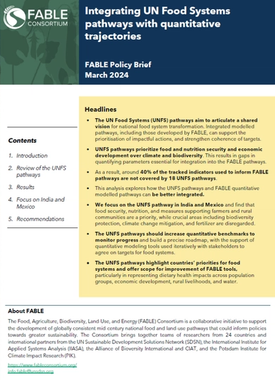
Integrating UN Food Systems Pathways with Quantitative Trajectories
A recent analysis conducted by the FABLE Consortium sheds light on the quantitative nature of the UN Food Systems (UNFS) National Pathways across 18 countries.
Downloads and Related Links
Overall, the UNFS pathways prioritize food security, nutrition, and economic development over climate change mitigation and biodiversity protection. The analysis reveals certain gaps in quantifying these pathways using modeling tools. Approximately 40% of the indicators tracked for FABLE pathways are not covered by UNFS pathways, signaling areas for target setting and alignment. Integrated quantitative trajectories, such as those developed by FABLE, can strengthen the UNFS pathways and support their operationalization.
UNFS pathways highlight countries’ food system priorities, as well as areas in which the FABLE Calculator could be improved, particularly in representing dietary health impacts, economic development, rural livelihoods, and water use. Using two country examples, India and Mexico, we demonstrate how both pathways can complement each other and identify opportunities for further integration. Moving forward, there is a need for UNFS pathways to establish more robust quantitative benchmarks for monitoring progress and roadmap development. Using quantitative modeling tools iteratively with stakeholders, particularly in UNFS Summit dialogues, can help address the absence of such benchmarks and facilitate target development for climate change mitigation, adaptation, and biodiversity protection within food systems that are consistent with other sustainability goals.